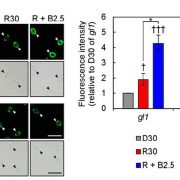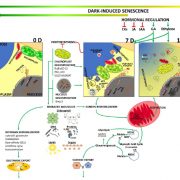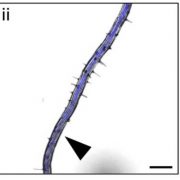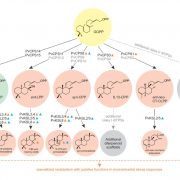
Red Light and the Plasma Membrane H+-ATPase in Guard Cells
Plant Physiology, Plant Physiology: On The InsideStomatal opening is stimulated by light, including blue and red light. Blue light-induced stomatal opening is fairly well understood: it is mediated by blue-light photoreceptor phototropins (phot1 and phot2). Blue light activates the plasma membrane (PM) H+-ATPase via phosphorylation of its penultimate…

Dark-Induced Leaf Senescence
Plant Physiology, Plant Physiology: On The InsideSenescence in plants is a prelude to cell or organ death. The metabolites and macromolecules released during senescence are salvaged by the plant for use elsewhere. Generally, senescence occurs prior to programmed cell death (PCD), since the characteristic leaf yellowing can be reversed while PCD is…

Esculin, a Sucrose Proxy for Phloem Transport
Plant Physiology, Plant Physiology: On The InsideThe study of phloem transport and its vital roles in long distance communication and carbon allocation have been hampered by a lack of suitable tools that allow high-throughput, real-time studies. Since the 1970s, several studies have used 11C or 14C isotopes to measure rates of phloem transport in large…

S-Sulfhydration Disrupts Actin Polymerization
Plant Physiology, Plant Physiology: On The InsideRecent evidence indicates that H2S acts as an important messenger that affects plant responses to abiotic stresses, including high salinity, drought, heat shock, heavy metals, and oxidative stress. H2S signaling has also been shown to modulate important physiological processes, such as photosynthesis,…

Sensory Plastids: a Novel Form of Specialized Plastid
Plant Physiology, Plant Physiology: On The InsidePlastids differentiate into subtypes. For example, the transition of proplastids to chloroplasts defines the photosynthetic tissues within a plant, whereas amyloplasts are formed in nonphotosynthetic tissues. Recently, evidence has accumulated for a novel class of plastids that is specialized for stress…

Arabidopsis Leaf Shape Regulation
Blog, Plant Physiology, Plant Physiology: On The InsideLeaf morphology, both between species and within the same organism,
is diverse: leaves can be simple or compound; they can have margins that are smooth or serrated, and they can be flat or have various curvatures. In Arabidopsis, leaf development starts with extensive cell proliferation throughout…

Variations in Leaf Intercellular Air Spaces
Blog, Plant Physiology, Plant Physiology: On The InsideDuring the course of evolution, the invasion of lands by plants exposed plant tissues to air,
which dramatically lowered the resistance for CO2 diffusion to chloroplasts by ~10,000-fold. The evolutionary development of the leaf intercellular airspace was a key innovation that allowed land plants…

Long-Days Enhance Jasmonic Acid-Related Plant Defense
Blog, Plant Physiology, Plant Physiology: News and Views, Plant Physiology: On The InsideDepending on the species, daylength profoundly affects the timing of key developmental transitions in plants, including, floral initiation, tuberization, and bud set and growth cessation in trees. To explore additional effects of daylength on plant function, Cagnola et al. (10.1104/pp.18.00443) investigated…

Diterpenoid Metabolism in Switchgrass
Blog, Plant Physiology, Plant Physiology: On The InsideSwitchgrass (Panicum virgatum) is a perennial C4 grass native to North America primarily valued as a next-generation feedstock for biofuel production. Its high net energy yield and
wide habitat range make switchgrass an attractive crop for cultivation on marginal lands with minimal agronomic inputs,…

